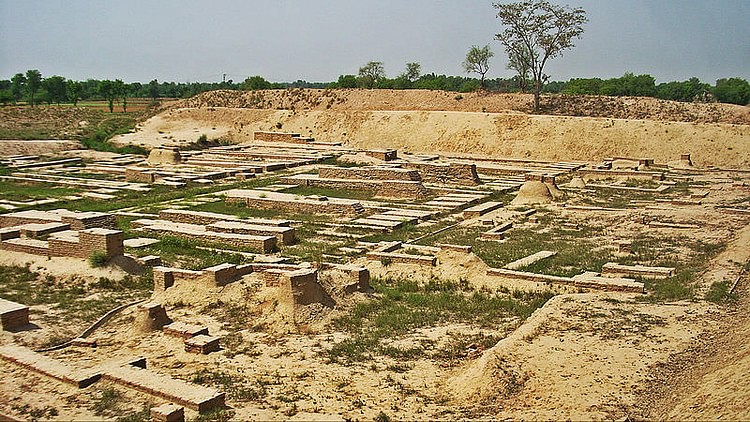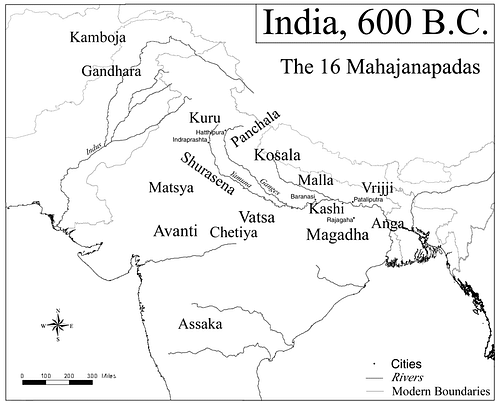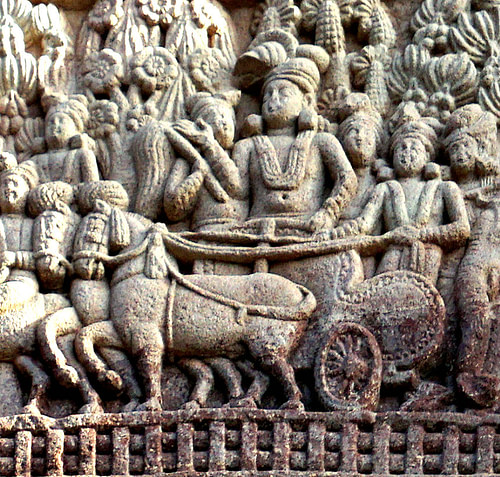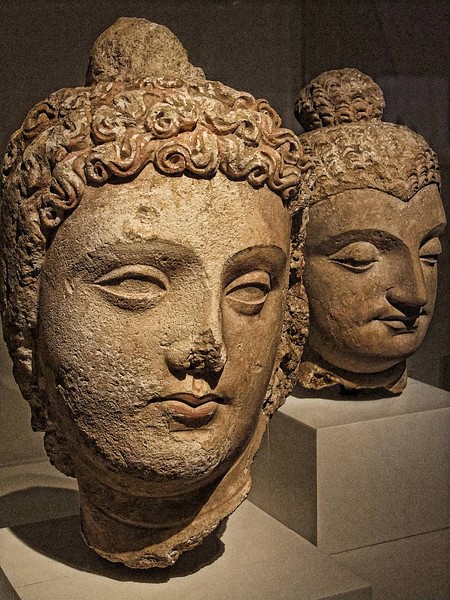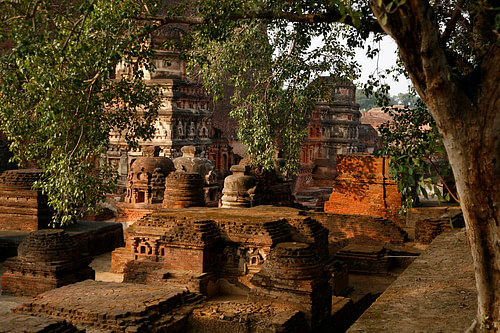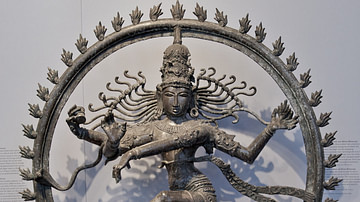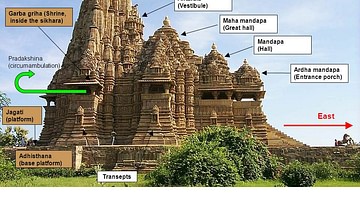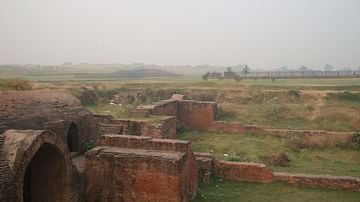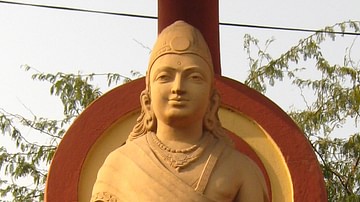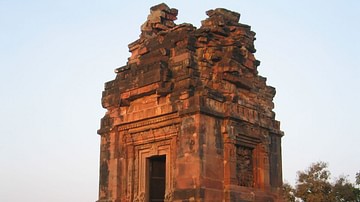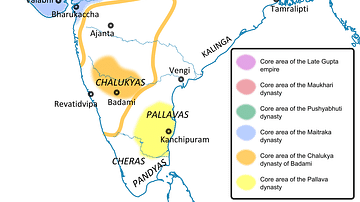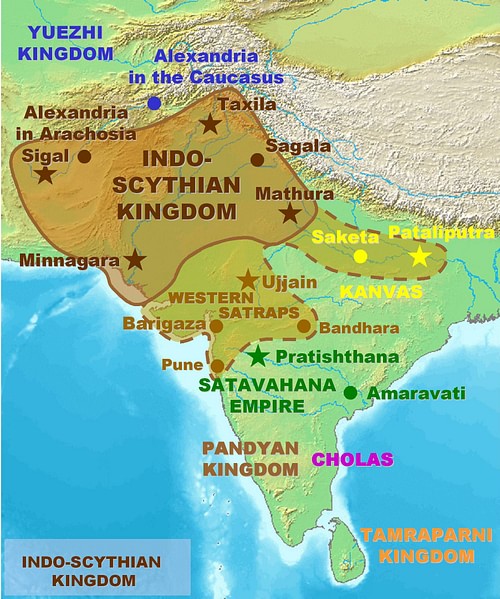
India is a country in South Asia whose name comes from the Indus River. The name 'Bharata' is used as a designation for the country in their constitution referencing the ancient mythological emperor, Bharata, whose story is told, in part, in the Indian epic Mahabharata.
According to the writings known as the Puranas (religious/historical texts written down in the 5th century CE), Bharata conquered the whole subcontinent of India and ruled the land in peace and harmony. The land was, therefore, known as Bharatavarsha (`the subcontinent of Bharata'). Hominid activity in the Indian subcontinent stretches back over 250,000 years, and it is, therefore, one of the oldest inhabited regions on the planet.
Archaeological excavations have discovered artifacts used by early humans, including stone tools, which suggest an extremely early date for human habitation and technology in the area. While the civilizations of Mesopotamia and Egypt have long been recognized for their celebrated contributions to civilization, India has often been overlooked, especially in the West, though its history and culture is just as rich. The Indus Valley Civilization (c. 7000-c. 600 BCE) was among the greatest of the ancient world, covering more territory than either Egypt or Mesopotamia and producing an equally vibrant and progressive culture.
It is the birthplace of four great world religions - Hinduism, Jainism, Buddhism, and Sikhism - as well as the philosophical school of Charvaka which influenced the development of scientific thought and inquiry. The inventions and innovations of the people of ancient India include many aspects of modern life taken for granted today including the flush toilet, drainage and sewer systems, public pools, mathematics, veterinary science, plastic surgery, board games, yoga and meditation, as well as many more.
Prehistory of India
The areas of present-day India, Pakistan, and Nepal have provided archaeologists and scholars with the richest sites of the most ancient pedigree. The species Homo heidelbergensis (a proto-human who was an ancestor of modern Homo sapiens) inhabited the subcontinent of India centuries before humans migrated into the region known as Europe. Evidence of the existence of Homo heidelbergensis was first discovered in Germany in 1907 and, since, further discoveries have established fairly clear migration patterns of this species out of Africa.
Recognition of the antiquity of their presence in India has been largely due to the fairly late archaeological interest in the area as, unlike work in Mesopotamia and Egypt, western excavations in India did not begin in earnest until the 1920s. Though the ancient city of Harappa was known to exist as early as 1829, its archaeological significance was ignored and the later excavations corresponded to an interest in locating the probable sites referred to in the great Indian epics Mahabharata and Ramayana (both of the 5th or 4th centuries BCE) while ignoring the possibility of a much more ancient past for the region.
The village of Balathal (near Udaipur in Rajasthan), to cite only one example, illustrates the antiquity of India's history as it dates to 4000 BCE. Balathal was not discovered until 1962 and excavations were not begun there until the 1990s CE. Even older is the Neolithic site of Mehrgarh, dated at c. 7000 BCE but showing evidence of even earlier habitation, which was not discovered until 1974.
Archaeological excavations in the past 50 years have dramatically changed the understanding of India's past and, by extension, world history. A 4000-year-old skeleton discovered at Balathal in 2009 provides the oldest evidence of leprosy in India. Prior to this find, leprosy was considered a much younger disease thought to have been carried from Africa to India at some point and then from India to Europe by the army of Alexander the Great following his death in 323 BCE.
It is now understood that significant human activity was underway in India by the Holocene Period (10,000 years ago) and that many historical assumptions, based upon earlier work in Egypt and Mesopotamia, need to be reviewed and revised. The beginnings of the Vedic tradition in India, still practiced today, can now be dated, at least in part, to the indigenous people of ancient sites such as Balathal and their interaction and blending with the culture of Aryan migrants who arrived in the region between c. 2000-c. 1500 BCE, initiating the so-called Vedic Period (c. 1500-c.500 BCE) during which the Hindu scriptures known as the Vedas were committed to written form.
Mohenjo-daro & Harappan Civilization
The Indus Valley Civilization dates to c. 7000 BCE and grew steadily throughout the lower Gangetic Valley region southwards and northwards to Malwa. The cities of this period were larger than contemporary settlements in other countries, were situated according to cardinal points, and were built of mud bricks, often kiln-fired. Houses were constructed with a large courtyard opening from the front door, a kitchen/workroom for the preparation of food, and smaller bedrooms.
Family activities seem to have centered on the front of the house, particularly the courtyard and, in this, are similar to what has been inferred from sites in Rome, Egypt, Greece, and Mesopotamia. The buildings and homes of the Indus Valley peoples, however, were far more advanced technologically with many featuring flush toilets and "wind catchers" (possibly first developed in ancient Persia) on the rooftops which provided air conditioning. The sewer and drainage systems of the cities excavated thus far are more advanced than those of Rome at its height.
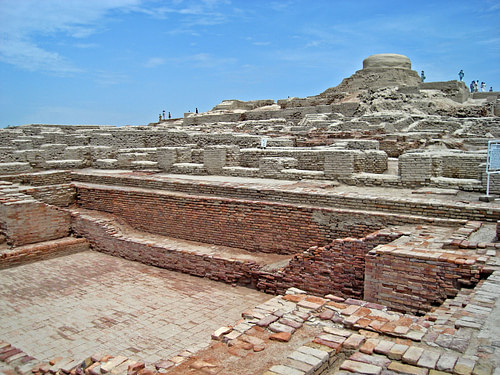
The most famous sites of this period are the great cities of Mohenjo-Daro and Harappa both located in present-day Pakistan (Mohenjo-daro in the Sindh province and Harappa in Punjab) which was part of India until the 1947 partition of the country which created the separate nation. Harappa has given its name to the Harappan Civilization (another name for the Indus Valley Civilization) which is usually divided into Early, Middle, and Mature periods corresponding roughly to 5000-4000 BCE (Early), 4000-2900 BCE (Middle), and 2900-1900 BCE (Mature). Harappa dates from the Middle period (c. 3000 BCE) while Mohenjo-Daro was built in the Mature period (c. 2600 BCE).
Harappa's buildings were severely damaged and the site compromised in the 19th century when British workers carried away a significant amount of material for use as ballast in constructing the railroad. Prior to this time, many buildings had already been dismantled by citizens of the local village of Harappa (which gives the site its name) for use in their own projects. It is therefore now difficult to determine the historical significance of Harappa save that it is clear it was once a significant Bronze Age community with a population of as many as 30,000 people.
Mohenjo-Daro, on the other hand, is much better preserved as it lay mostly buried until 1922. The name Mohenjo-Daro means `mound of the dead' in Sindhi and was applied to the site by local people who found bones of humans and animals there, as well as ancient ceramics and other artifacts, emerging from the soil periodically. The original name of the city is unknown although various possibilities have been suggested by finds in the region, among them, the Dravidian name `Kukkutarma', the city of the cock, a possible allusion to the site now known as Mohenjo-Daro as a center of ritual cock-fighting or, perhaps, as a breeding center for cocks.
Mohenjo-Daro was an elaborately constructed city with streets laid out evenly at right angles and a sophisticated drainage system. The Great Bath, a central structure at the site, was heated and seems to have been a focal point for the community. The citizens were skilled in the use of metals such as copper, bronze, lead, and tin (as evidenced by artworks such as the bronze statue of the Dancing Girl and by individual seals) and cultivated barley, wheat, peas, sesame, and cotton. Trade was an important source of commerce and it is thought that ancient Mesopotamian texts which mention Magan and Meluhha refer to India generally or, perhaps, Mohenjo-Daro specifically. Artifacts from the Indus Valley region have been found at sites in Mesopotamia though their precise point of origin in India is not always clear.
Decline of Harappan Civilization
The people of the Harappan Civilization worshipped many gods and engaged in ritual worship. Statues of various deities (such as Indra, the god of storm and war) have been found at many sites and, chief among them, terracotta pieces depicting the Shakti (the Mother Goddess) suggesting a popular, common worship of the feminine principle. In c. 2000 - c.1500 BCE it is thought another race, known as the Aryans, migrated into India through the Khyber Pass and assimilated into the existing culture, bringing their gods and the language of Sanskrit with them which they then introduced to the region's existing belief system. Who the Aryans were and what effect they had on the indigenous people continues to be debated but it is generally acknowledged that, at about the same time as their arrival, the Harappan culture began to decline.
Scholars cite climate change as one possible reason noting evidence of both drought and flood in the region. The Indus River is thought to have begun flooding the region more regularly (as evidenced by approximately 30 feet or 9 meters of silt at Mohenjo-Daro) and this destroyed crops and encouraged famine. It is also thought the path of the monsoon, relied upon for watering the crops, could have changed and people left the cities in the north for lands in the south. Another possibility is loss of trade relations with Mesopotamia and Egypt, their two most vital partners in commerce, as both of those regions were undergoing domestic conflicts at this same time.
Racialist writers and political philosophers of the early 20th century, following the lead of the German philologist Max Muller (l. 1823-1900), claimed the Indus Valley Civilization fell to an invasion of light-skinned Aryans but this theory has now long been discredited. Equally untenable is the theory that the people were driven south by extra-terrestrials. Among the most mysterious aspects of Mohenjo-daro is the vitrification of parts of the site as though it had been exposed to intense heat which melted the brick and stone. This same phenomenon has been observed at sites such as Traprain Law in Scotland and attributed to the results of warfare. Speculation regarding the destruction of the city by some kind of ancient atomic blast, however, (the work of aliens from other planets) is not generally regarded as credible.
The Vedic Period
Whatever the reason for the abandonment of the cities, the period that followed the decline of the Indus Valley Civilization is known as the Vedic Period, characterized by a pastoral lifestyle and adherence to the religious texts known as The Vedas. Society became divided into four classes (the Varnas) popularly known as 'the caste system' which were comprised of the Brahmana at the top (priests and scholars), the Kshatriya next (the warriors), the Vaishya (farmers and merchants), and the Shudra (laborers). The lowest caste was the Dalits, the untouchables, who handled meat and waste, though there is some debate over whether this class existed in antiquity.
At first, it seems this caste system was merely a reflection of one's occupation but, in time, it became more rigidly interpreted to be determined by one's birth and one was not allowed to change castes nor to marry into a caste other than one's own. This understanding was a reflection of the belief in an eternal order to human life dictated by a supreme deity.
While the religious beliefs which characterized the Vedic Period are considered much older, it was during this time that they became systematized as the religion of Sanatan Dharma ('Eternal Order') known today as Hinduism (this name deriving from the Indus (or Sindus) River where worshippers were known to gather, hence, 'Sindus', and then 'Hindus'). The underlying tenet of Sanatan Dharma is that there is an order and a purpose to the universe and human life and, by accepting this order and living in accordance with it, one will experience life as it is meant to be properly lived.
While Sanatan Dharma is considered by many a polytheistic religion consisting of many gods, it is actually monotheistic in that it holds there is one god, Brahman (the Self but also the Universe and creator of the observable universe), who, because of his greatness, cannot be fully apprehended save through the many aspects which are revealed as the different gods of the Hindu pantheon.
It is Brahman who decrees the eternal order and maintains the universe through it. This belief in an order to the universe reflects the stability of the society in which it grew and flourished as, during the Vedic Period, governments became centralized and social customs integrated fully into daily life across the region. Besides The Vedas, the great religious and literary works of the Puranas, the Mahabharata, Bhagavad-Gita, and the Ramayana all come from this period.
In the 6th century BCE, the religious reformers Vardhamana Mahavira (l. c. 599-527 BCE) and Siddhartha Gautama (l. c. 563 to c. 483 BCE) developed their own belief systems and broke away from mainstream Sanatan Dharma to eventually create their own religions of Jainism and Buddhism, respectively. These changes in religion were a part of a wider pattern of social and cultural upheaval which resulted in the formation of city-states and the rise of powerful kingdoms (such as the Magadha Kingdom under the ruler Bimbisara) and the proliferation of philosophical schools of thought which challenged orthodox Hinduism.
Mahavira rejected the Vedas and placed the responsibility for salvation and enlightenment directly on the individual and the Buddha would later do the same. The philosophical school of Charvaka rejected all supernatural elements of religious belief and maintained that only the senses could be trusted to apprehend the truth and, further, that the greatest goal in life was pleasure and one's own enjoyment. Although Charvaka did not endure as a school of thought, it influenced the development of a new way of thinking which was more grounded, pragmatic, and eventually encouraged the adoption of empirical and scientific observation and method.
Cities also expanded during this time and the increased urbanization and wealth attracted the attention of Cyrus II (the Great, r. c. 550-530 BCE) of the Persian Achaemenid Empire (c. 550-330 BCE) who invaded India in 530 BCE and initiated a campaign of conquest in the region. Ten years later, under the reign of his son, Darius I (the Great, r. 522-486 BCE), northern India was firmly under Persian control (the regions corresponding to Afghanistan and Pakistan today) and the inhabitants of that area subject to Persian laws and customs. One consequence of this, possibly, was an assimilation of Persian and Indian religious beliefs which some scholars point to as an explanation for further religious and cultural reforms.
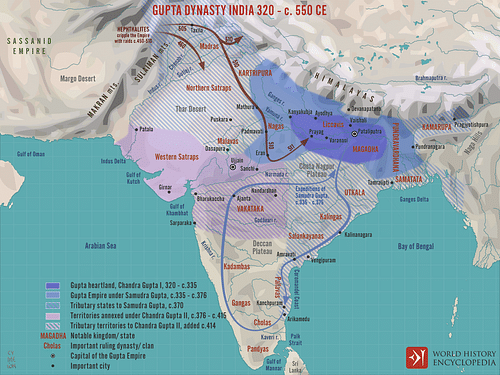
The Great Empires of Ancient India
Persia held dominance in northern India until the conquest of Alexander the Great in 330 BCE who marched on India after Persia had fallen. Again, foreign influences were brought to bear on the region giving rise to the Greco-Buddhist culture which impacted all areas of culture in northern India from art to religion to dress. Statues and reliefs from this period depict Buddha, and other figures, as distinctly Hellenic in dress and pose (known as the Gandhara School of Art). Following Alexander's departure from India, the Mauryan Empire (322-185 BCE) rose under the reign of Chandragupta Maurya (r. c. 321-297 BCE) until, by the end of the third century BCE, it ruled over almost all of northern India.
Chandragupta's son, Bindusara (r. 298-272 BCE) extended the empire throughout almost the whole of India. His son was Ashoka the Great (r. 268-232 BCE) under whose rule the empire flourished at its height. Eight years into his reign, Ashoka conquered the eastern city-state of Kalinga which resulted in a death toll numbering over 100,000. Shocked at the destruction and death, Ashoka embraced the teachings of the Buddha and embarked on a systematic program advocating Buddhist thought and principles.
He established many monasteries, gave lavishly to Buddhist communities, and is said to have erected 84,000 stupas across the land to honor the Buddha. In 249 BCE, on pilgrimage to sites associated with the Buddha's life, he formally established the village of Lumbini as Buddha's birthplace, erecting a pillar there, and commissioned the creation of his famous Edicts of Ashoka to encourage Buddhist thought and values. Prior to Ashoka's reign, Buddhism was a small sect struggling to gain adherents. After Ashoka sent missionaries to foreign countries carrying the Buddhist vision, the small sect began to grow into the major religion it is today.
The Mauryan Empire declined and fell after Ashoka's death and the country splintered into many small kingdoms and empires (such as the Kushan Empire) in what has come to be called the Middle Period. This era saw the increase of trade with Rome (which had begun c. 130 BCE) following Augustus Caesar's incorporation of Egypt into the newly established Roman Empire in 30 BCE. Rome now became India's primary partner in trade as the Romans also had already annexed much of Mesopotamia. This was a time of individual and cultural development in the various kingdoms which finally flourished in what is considered the Golden Age of India under the reign of the Gupta Empire (320-550 CE).
The Gupta Empire is thought to have been founded by one Sri Gupta (`Sri' means `Lord') who probably ruled between 240-280 CE. As Sri Gupta is thought to have been of the Vaishya (merchant) class, his rise to power in defiance of the caste system is unprecedented. He laid the foundation for the government which would so stabilize India that virtually every aspect of culture reached its height under the reign of the Guptas. Philosophy, literature, science, mathematics, architecture, astronomy, technology, art, engineering, religion, and astronomy, among other fields, all flourished during this period, resulting in some of the greatest of human achievements.
The Puranas of Vyasa were compiled during this period and the famous caves of Ajanta and Ellora, with their elaborate carvings and vaulted rooms, were also begun. Kalidasa the poet and playwright wrote his masterpiece Shakuntala and the Kamasutra was also written, or compiled from earlier works, by Vatsyayana. Varahamihira explored astronomy at the same time as Aryabhatta, the mathematician, made his own discoveries in the field and also recognized the importance of the concept of zero, which he is credited with inventing. As the founder of the Gupta Empire defied orthodox Hindu thought, it is not surprising that the Gupta rulers advocated and propagated Buddhism as the national belief and this is the reason for the plentitude of Buddhist works of art, as opposed to Hindu, at sites such as Ajanta and Ellora.
The Decline of Empire & the Coming of Islam
The empire declined slowly under a succession of weak rulers until it collapsed around 550 CE. The Gupta Empire was then replaced by the rule of Harshavardhan (590-647 CE) who ruled the region for 42 years. A literary man of considerable accomplishments (he authored three plays in addition to other works) Harsha was a patron of the arts and a devout Buddhist who forbade the killing of animals in his kingdom but recognized the necessity to sometimes kill humans in battle.
He was a highly skilled military tactician who was only defeated in the field once in his life. Under his reign, the north of India flourished but his kingdom collapsed following his death. The invasion of the Huns had been repeatedly repelled by the Guptas and then by Harshavardhan but, with the fall of his kingdom, India fell into chaos and fragmented into small kingdoms lacking the unity necessary to fight off invading forces.
In 712 CE the Muslim general Muhammed bin Quasim conquered northern India, establishing himself in the region of modern-day Pakistan. The Muslim invasion saw an end to the indigenous empires of India and, from then on, independent city-states or communities under the control of a city would be the standard model of government. The Islamic Sultanates rose in the region of modern-day Pakistan and spread north-west.
The disparate world views of the religions which now contested each other for acceptance in the region and the diversity of languages spoken, made the unity and cultural advances, such as were seen in the time of the Guptas, difficult to reproduce. Consequently, the region was easily conquered by the Islamic Mughal Empire. India would then remain subject to various foreign influences and powers (among them the Portuguese, the French, and the British) until finally winning its independence in 1947.
